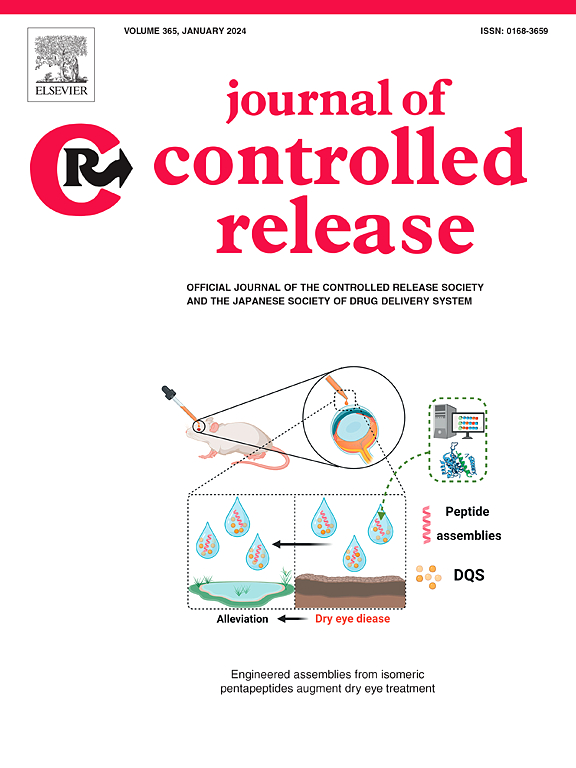Acid-activated mitochondria-targeting nanoprodrug for reactive oxygen species (ROS)-tolerant cancer therapy via antioxidant defense inhibition
IF 10.5
1区 医学
Q1 CHEMISTRY, MULTIDISCIPLINARY
引用次数: 0
Abstract
The intracellular balance of reactive oxygen species (ROS) is crucial for cancer cell survival and tumor development, with mitochondria playing a key role in maintaining this balance through antioxidant defenses. Despite the efficacy of ROS-modulating strategies in many tumors, certain ROS-tolerant malignancies, such as HepG2 cells, pose significant therapeutic challenges due to their robust antioxidant systems and unique redox microenvironments. In this work, we have developed a self-amplifying nanoprodrug (nCACT) designed to target ROS-tolerant tumor cells. nCACT is constructed from a prodrug conjugate that combines a glutathione (GSH)-depleting chemotherapeutic agent, a mitochondria-targeting moiety, and a ROS-stimulated amplifying linker. The nCACT leverages the enhanced permeability and retention effect for tumor accumulation and cellular uptake, followed by acid-activated drug release and mitochondrial targeting. By disrupting ROS defense mechanisms and inducing mitochondrial dysfunction, nCACT effectively elevates ROS levels and depletes GSH, suppressing cancer cell growth. Our findings demonstrate that nCACT represents a novel and powerful strategy for overcoming ROS resistance in cancer therapy, offering a promising avenue for treating ROS-tolerant malignancies.

酸激活线粒体靶向纳米前药通过抗氧化防御抑制对活性氧(ROS)耐受癌症进行治疗
细胞内活性氧(ROS)的平衡对癌细胞的生存和肿瘤的发展至关重要,线粒体通过抗氧化防御在维持这种平衡中起着关键作用。尽管ros调节策略在许多肿瘤中有效,但某些ros耐受的恶性肿瘤,如HepG2细胞,由于其强大的抗氧化系统和独特的氧化还原微环境,带来了重大的治疗挑战。在这项工作中,我们开发了一种自我扩增的纳米前药(nact),旨在靶向ros耐受的肿瘤细胞。nact由前药偶联物构建,结合了谷胱甘肽(GSH)消耗化疗药物,线粒体靶向片段和ros刺激的扩增连接物。nact利用增强的渗透性和滞留效应来促进肿瘤积聚和细胞摄取,随后是酸激活的药物释放和线粒体靶向。nact通过破坏ROS防御机制,诱导线粒体功能障碍,有效提高ROS水平,消耗GSH,抑制癌细胞生长。我们的研究结果表明,nact代表了在癌症治疗中克服ROS耐药性的一种新颖而有力的策略,为治疗ROS耐受的恶性肿瘤提供了一条有希望的途径。
本文章由计算机程序翻译,如有差异,请以英文原文为准。
求助全文
约1分钟内获得全文
求助全文
来源期刊

Journal of Controlled Release
医学-化学综合
CiteScore
18.50
自引率
5.60%
发文量
700
审稿时长
39 days
期刊介绍:
The Journal of Controlled Release (JCR) proudly serves as the Official Journal of the Controlled Release Society and the Japan Society of Drug Delivery System.
Dedicated to the broad field of delivery science and technology, JCR publishes high-quality research articles covering drug delivery systems and all facets of formulations. This includes the physicochemical and biological properties of drugs, design and characterization of dosage forms, release mechanisms, in vivo testing, and formulation research and development across pharmaceutical, diagnostic, agricultural, environmental, cosmetic, and food industries.
Priority is given to manuscripts that contribute to the fundamental understanding of principles or demonstrate the advantages of novel technologies in terms of safety and efficacy over current clinical standards. JCR strives to be a leading platform for advancements in delivery science and technology.
 求助内容:
求助内容: 应助结果提醒方式:
应助结果提醒方式:


